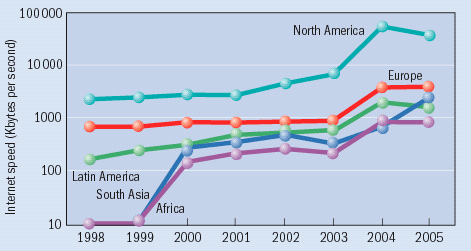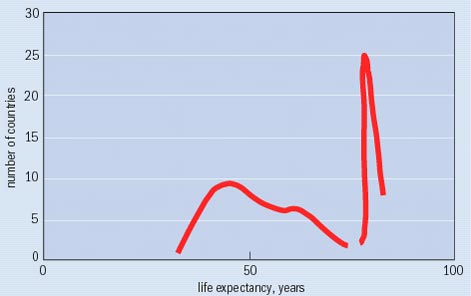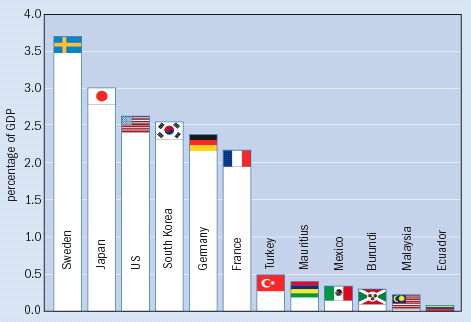As the World Year of Physics draws to a close, delegates from around the world are meeting in South Africa this month to discuss how science can improve the lives of people in developing nations. Katepalli Sreenivasan explains why physics has such a vital role to play

At a Glance: Physics and the developing world
- The World Year of Physics culminates this month with a major meeting in South Africa on physics and sustainable development
- The problems of the developing world concern us all because the world is an increasingly connected place
- Investment in science is vital for developing nations, but they often fail to see the benefits it brings
- Physics can play a key role in creating new technologies for, say, clean drinking water New world-class centres of excellence will also be vital for boosting science in the developing world
When the leaders of the world’s main industrialized nations met at the G8 summit in Scotland in July, the issues of Africa and climate change were at the top of the agenda. Certainly it was good to see that aid to developing nations will be boosted by $50bn and that the debts of the 18 poorest nations will be cancelled. However, it was disappointing that science did not figure as prominently in the leaders’ final communiqué as one might have hoped.
Nevertheless, there was a clear recognition that science makes important contributions to society. In particular, the G8 leaders made a firm commitment to support centres of excellence in the developing world, which are vital for producing the skilled scientific professionals of the future. My hope is that many African nations – with their debt burdens now reduced or removed – will invest more in science and set up world-class centres that will, over time, transform the scientific scene. Creating scientifically educated people is the best investment that a country can make.
The importance of science in the developing world is also the theme of a major international conference taking place in Durban, South Africa, from 31 October to 2 November this year. Entitled “Physics and sustainable development”, it is the formal culmination of the World Year of Physics, during which physicists have been celebrating the three groundbreaking achievements made by Einstein in 1905. Over 500 delegates from around the world are expected to attend, including representatives from business and the private sector. Potential donors such as the World Bank, the European Commission and the African Development Bank have been invited to support specific projects that will be discussed at meeting.
The conference will focus on four main themes: physics and health; physics and economic development; physics education; and energy and the environment. It will thereby give the international physics community the chance to show some of the benefits of physics to the wider world. Delegates will also discuss why science is not more central to the political and social fabric of developing nations, and what can be done to change that situation. If politicians can be persuaded to improve science in the developing world, the conference – and the World Year of Physics – will have been a success.
Living in an interconnected world
It requires no great insight to observe that we now live in a world of increased connectivity, in which we travel far, communicate quickly and easily, and conduct business with distant customers. It is also a world in which we share the tragedies of disasters. Consider the catastrophic tsunami last December, which began 350 km off the north-western tip of Sumatra in Indonesia and barrelled quickly across the Indian Ocean killing some 300 000 people in Southeast Asia. In total, citizens from more than 30 countries were affected, with Sweden – a country far from the Indian Ocean – alone losing more than 550 lives.
Despite the world becoming more interconnected, it is also clear that we live in a divided world. The average per-capita income in industrialized nations is $27 000 per year, compared with barely $2000 or so in the developing world. Literacy rates approach 100% of the adult population in developed countries, but the figure falls to below 50% in developing nations. While the Internet has helped global communication and its use is rising everywhere, the proportion of people with access to it is far higher in rich nations than it is in poor nations . And as life expectancy in the developed world approaches 80 years of age, it is slipping towards 40 in the world’s poorest countries.
The economist Jeffrey Sachs, who is a special advisor to the UN secretary-general Kofi Annan, has described the endless tragedies that afflict the developing world due to poverty, disease and environmental degradation as “silent tsunamis”. He also suggests that such events are aggravated by a lack of access to science and technology. Indeed, Abdus Salam – the Nobel-prize-winning Pakistani physicist who founded the International Centre for Theoretical Physics (ICTP) in Trieste, Italy – often argued that scientists in rich nations must work towards reducing the imbalance between the rich and the poor.
Unfortunately, the disparities are widening. Mitigating them is not just a moral imperative, but is also in the self-interest of developed nations because the consequences of neglecting today’s problems are too vast to contemplate. After all, most of the Earth’s population lives in developing nations, which means that we are all in it together, if only because we share both the fruits and perils of the future.
The importance of scientific investment
Science – and physics in particular – can play a major role in solving the problems facing humanity. Of course, science does not have all the answers and not all scientific advances have benefited society. One need look no further than nuclear weapons, which remain a major international concern. Yet, on balance, the contributions of science have been positive and significant. Being largely devoid of political, economic and religious influences, science has the power to form consensus between people.
Moreover, only scientific knowledge can help governments decide which technologies are needed to solve problems in a particular country. Although economics, politics, public acceptability, technological simplicity and other socio-economic factors play a role, science and good engineering are what ultimately count. From electricity and transport to computers and the Internet, physics has laid the foundation for numerous transforming technologies over the past 200 years. And with the need to develop cleaner energy and mitigate the adverse effects of climate change, for example, society will increasingly depend on physics to understand and solve its problems.
Yet scientific investment in developing countries is woefully inadequate. In the West, the proportion of gross domestic product (GDP) devoted to research and development averages between 2.5% and 4%, with Sweden (3.7%), Japan (3.0%) and the US (2.6%) leading the way. However, the equivalent figures in the developing world are often substantially less than 0.5%, with Ecuador, for example, spending just 0.08% of its GDP on research. Only a handful of developing countries – notably Brazil, China and India – have managed to boost their spending to above 1%.
Unfortunately, many nations fail to appreciate the benefits of science. Instead, they associate it with some of the more negative effects of modern life, such as fumes from incessant traffic, the pollution of land by oil refineries, and the use of increasingly deadly weapons. They shy away from science because of such dark images.
Too many developing countries also fail to see that science enables technological innovation, which is vital for economic development and wealth creation. Estimates from a number of sources, such as the UK’s Office of Science and Technology, have shown that sustained public investments in science generate returns of between 20% and 65% a year. The immense economic gains made by Japan since the Second World War – and more recently by South Korea – are almost entirely due to science and technology.
The lack of investment in turn means that many scientists in developing nations feel alienated from their own societies, which tend to view science as a product of the industrialized world. These scientists often migrate to lucrative jobs in the US, Europe and Japan, making it even harder to create an educated workforce in their home countries. The result is that barely one in every million people in sub-Saharan Africa (excluding South Africa) is estimated to have a PhD degree; in the US, the proportion is about a thousand times greater.
Perhaps equally importantly, investment in science and help for entrepreneurs in developing nations are held back by monetary policies that are driven by regressive forms of taxation and a dependence on hand-outs. The tremendous financial contributions made by private organizations such as the Bill and Melinda Gates Foundation are partly spurred by the favourable tax incentives in the US. Other factors holding back scientific investment include unstable political environments that cultivate corruption and instability, as well as exploitation by rich countries.
Opportunities for physics
The huge technological developments of the last century have, of course, come with a price tag. In particular, our use of the Earth’s finite resources – triggered by the insatiable demands of the world’s increasing population – has escalated. Managing these resources without depleting them for good – a concept known as “sustainable development” – is one of the most urgent challenges we face today.
The Millennium Development Goals – a series of ambitious targets that UN members agreed to reach by 2015 – provide a clear vision for sustainable development. They include, for example, a 50% cut in the number of people who do not have sustainable access to safe drinking water, as well as targets for reducing poverty and improving public healthcare.
Physics will play a critical role in attaining these goals. Taking clean water as an example, membranes that are made from carbon nanotubes – rolled-up 2D sheets of graphite – can be used to block the passage of bacteria, viruses, heavy metals and other pollutants. They can therefore be used as effective filters for purifying water. Indeed, laboratory experiments at the Rensselaer Institute in Troy, New York, and the Banaras Hindu University in Varanasi, India, have demonstrated that carbon-nanotube filters can remove polio viruses 25 nm in size from water, as well as larger pathogens such as E. coli and Staphilococcus aureus bacteria. Carbon nanotubes can also withstand relatively high temperatures, which means the filter could be unclogged periodically by heating it; conventional polymer-based water filters, in contrast, are destroyed if heated.
Meanwhile, natural tracers such as tritium, helium-3 and carbon-14 – in conjunction with chemical and hydrological measurements – can be used to determine where ground water has come from and whether it has been contaminated with pollutants. Such information is critical for determining if the water is safe to drink. Other applications of physics include the development of recyclable polymeric nanocomposites that may replace metals and other materials that are currently used in industrial manufacturing. Telemedicine links, using broadband communication, could bring healthcare services to remote areas of the developing world. Novel recyclable materials could be produced by nanotechnology and self assembly of molecules, while genetic engineering could help to develop foods and plants such as cotton that are resistant to harmful insects.
Indeed, we could be on the cusp of a new “golden age” of physics, inspired by the ideas of sustainable development. The previous golden age, which lasted from the 1940s to the 1980s, was driven largely by the national-security concerns that preoccupied the world’s two superpowers, the US and the Soviet Union. The new golden age will be different. It will have clear economic and social consequences, it will be interdisciplinary in nature, and will take place across the globe, rather than in just a handful of nations.
So if we are to be serious about encouraging sustainable development, we will have to boost scientific capacity throughout the developing world. The focus should not be on technology transfer, but on nurturing scientific talent. One way of doing this is through institutions like the ICTP, which has brought some 100,000 scientists from developing and developed worlds together in roughly equal numbers over the last 40 years. Ultimately, however, each nation has to develop its own base of scientific knowledge.
The way ahead
While several Asian and Latin American countries have recently begun to rectify their lack of investment in science, developing countries must invest in talented young scientists to ensure that they fulfil their potential. As the recent economic boom in China makes clear, it is reaping the rewards of a massive effort in the 1980s and 1990s to educate young Chinese students at overseas universities.
Developing countries must also create research institutions that reward excellence, so that young scientists can see a future in their own nations. While this effort must encompass universities, research institutes and scientific academies, it will be particularly important to create a few world-class centres of excellence in different regions of the world. Scientific talent and know-how can then be maximized by forming a network of such centres. This will also help foster collaboration between physicists, biologists, medical professionals and engineers, which is essential to effectively tackle the environmental, healthcare, communications and materials-science issues facing developing nations.
Balancing development and sustainability will not be easy in developing nations, particularly given their growing populations and their fast-increasing energy needs. But two things are clear. First, there are not enough resources on the planet for the developing world to follow the same path to economic growth that the industrialized countries followed themselves. The developing world has to show greater ingenuity and generate alternative solutions, which calls for even greater investment in science. Second, the rest of the world has to become an engaged and benign partner in the fate of the developing nations. The consequences of unsustainable development in one part of the world will irretrievably damage us all.
More about: Physics and the developing world
Abdus Salam International Centre for Theoretical Physics: www.ictp.it
International Atomic Energy Agency: www.iaea.org
The Academy of Sciences for the Developing World: www.twas.org
UN Educational, Scientific and Cultural Organization: www.unesco.org
World Conference on Physics and Sustainable Development: www.wcpsd.org







